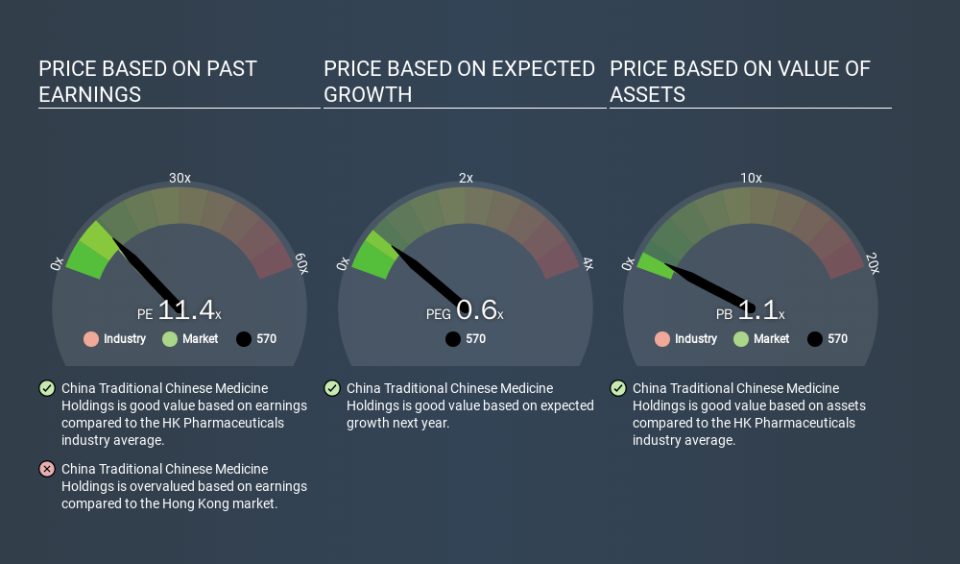Read This Before You Buy China Traditional Chinese Medicine Holdings Co. Limited (HKG:570) Because Of Its P/E Ratio

Today, we'll introduce the concept of the P/E ratio for those who are learning about investing. We'll look at China Traditional Chinese Medicine Holdings Co. Limited's (HKG:570) P/E ratio and reflect on what it tells us about the company's share price. China Traditional Chinese Medicine Holdings has a P/E ratio of 11.37, based on the last twelve months. That corresponds to an earnings yield of approximately 8.8%.
View our latest analysis for China Traditional Chinese Medicine Holdings
How Do You Calculate China Traditional Chinese Medicine Holdings's P/E Ratio?
The formula for P/E is:
Price to Earnings Ratio = Share Price (in reporting currency) ÷ Earnings per Share (EPS)
Or for China Traditional Chinese Medicine Holdings:
P/E of 11.37 = CNY3.47 (Note: this is the share price in the reporting currency, namely, CNY ) ÷ CNY0.31 (Based on the year to June 2019.)
Is A High Price-to-Earnings Ratio Good?
A higher P/E ratio means that investors are paying a higher price for each CNY1 of company earnings. That isn't necessarily good or bad, but a high P/E implies relatively high expectations of what a company can achieve in the future.
Does China Traditional Chinese Medicine Holdings Have A Relatively High Or Low P/E For Its Industry?
One good way to get a quick read on what market participants expect of a company is to look at its P/E ratio. The image below shows that China Traditional Chinese Medicine Holdings has a P/E ratio that is roughly in line with the pharmaceuticals industry average (11.5).
That indicates that the market expects China Traditional Chinese Medicine Holdings will perform roughly in line with other companies in its industry. So if China Traditional Chinese Medicine Holdings actually outperforms its peers going forward, that should be a positive for the share price. I would further inform my view by checking insider buying and selling., among other things.
How Growth Rates Impact P/E Ratios
Probably the most important factor in determining what P/E a company trades on is the earnings growth. That's because companies that grow earnings per share quickly will rapidly increase the 'E' in the equation. And in that case, the P/E ratio itself will drop rather quickly. And as that P/E ratio drops, the company will look cheap, unless its share price increases.
China Traditional Chinese Medicine Holdings increased earnings per share by 3.5% last year. And earnings per share have improved by 18% annually, over the last five years.
Remember: P/E Ratios Don't Consider The Balance Sheet
Don't forget that the P/E ratio considers market capitalization. In other words, it does not consider any debt or cash that the company may have on the balance sheet. In theory, a company can lower its future P/E ratio by using cash or debt to invest in growth.
Spending on growth might be good or bad a few years later, but the point is that the P/E ratio does not account for the option (or lack thereof).
How Does China Traditional Chinese Medicine Holdings's Debt Impact Its P/E Ratio?
Net debt totals just 6.1% of China Traditional Chinese Medicine Holdings's market cap. It would probably trade on a higher P/E ratio if it had a lot of cash, but I doubt it is having a big impact.
The Verdict On China Traditional Chinese Medicine Holdings's P/E Ratio
China Traditional Chinese Medicine Holdings trades on a P/E ratio of 11.4, which is above its market average of 10.0. With modest debt relative to its size, and modest earnings growth, the market is likely expecting sustained long-term growth, if not a near-term improvement.
Investors have an opportunity when market expectations about a stock are wrong. As value investor Benjamin Graham famously said, 'In the short run, the market is a voting machine but in the long run, it is a weighing machine. So this free visual report on analyst forecasts could hold the key to an excellent investment decision.
Of course, you might find a fantastic investment by looking at a few good candidates. So take a peek at this free list of companies with modest (or no) debt, trading on a P/E below 20.
If you spot an error that warrants correction, please contact the editor at editorial-team@simplywallst.com. This article by Simply Wall St is general in nature. It does not constitute a recommendation to buy or sell any stock, and does not take account of your objectives, or your financial situation. Simply Wall St has no position in the stocks mentioned.
We aim to bring you long-term focused research analysis driven by fundamental data. Note that our analysis may not factor in the latest price-sensitive company announcements or qualitative material. Thank you for reading.

